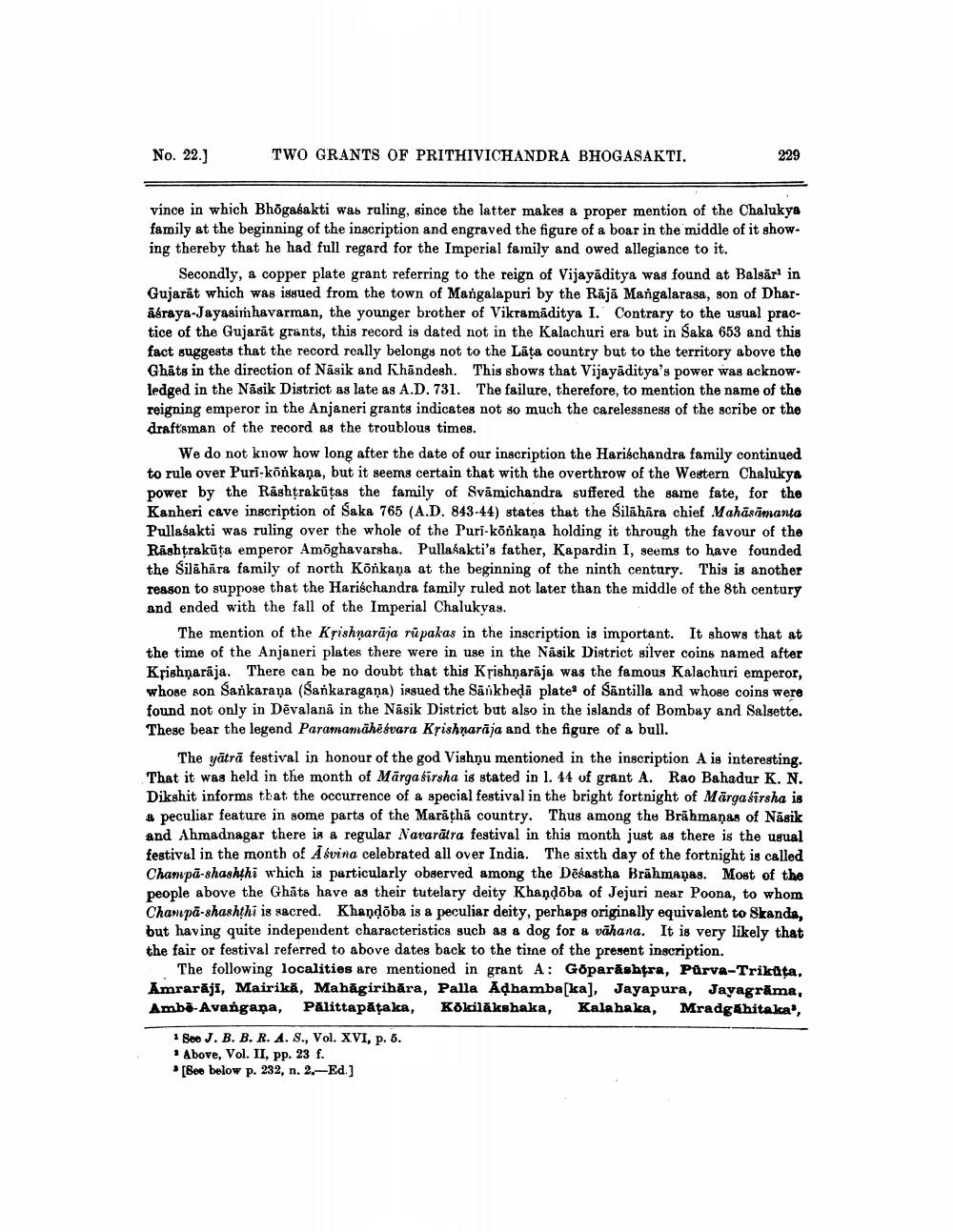________________
No. 22.]
TWO GRANTS OF PRITHIVICHANDRA BHOGASAKTI.
229
vince in which Bhögabakti was ruling, since the latter makes a proper mention of the Chalukya family at the beginning of the inscription and engraved the figure of a boar in the middle of it showing thereby that he had full regard for the Imperial family and owed allegiance to it.
Secondly, a copper plate grant referring to the reign of Vijayaditya was found at Balsăr' in Gujarāt which was issued from the town of Mangalapuri by the Rājā Mangalarasa, son of Dharābraya-Jayasinhavarman, the younger brother of Vikramāditya I. Contrary to the usual practice of the Gujarāt grants, this record is dated not in the Kalachuri era but in Saka 653 and this fact suggests that the record really belongs not to the Läta country but to the territory above the Ghats in the direction of Nāsik and Khāndesh. This shows that Vijayāditya's power was acknowledged in the Nāsik District as late as A.D. 731. The failure, therefore, to mention the name of the reigning emperor in the Anjaneri grants indicates not so much the carelessness of the scribe or the draftsman of the record as the troublous times.
We do not know how long after the date of our inscription the Harischandra family continued to rule over Puri-könkana, but it seems certain that with the overthrow of the Western Chalukya power by the Rashtrakūtas the family of Svāmichandra suffered the same fate, for the Kanheri cave inscription of Saka 765 (A.D. 843-44) states that the Silāhāra chief Mahāsāmanta Pullasakti was ruling over the whole of the Puri-konkaņa holding it through the favour of the Rashtrakūta emperor Amõghavarsha. Pulla akti's father, Kapardin I, seems to have founded the Silāhāra family of north Konkaņa at the beginning of the ninth century. This is another reason to suppose that the Hariéchandra family ruled not later than the middle of the 8th century and ended with the fall of the Imperial Chalukyan.
The mention of the Krishnarāja rūpakas in the inscription is important. It shows that at the time of the Anjaneri plates there were in use in the Nāsik District silver coins named after Krishnarāja. There can be no doubt that this Krishnarāja was the famous Kalachuri emperor, whose son Sankaraņa (Sankaragana) issued the Sārkhedā plate of Santilla and whose coins were found not only in Dēvalana in the Nāsik District but also in the islands of Bombay and Salsette. These bear the legend Paramamähēsvara Krishnarāja and the figure of a bull.
The yātrā festival in honour of the god Vishņu mentioned in the inscription A is interesting. That it was held in the month of Mārgaśīrsha is stated in 1. 44 of grant A. Rao Bahadur K. N. Dikshit informs that the occurrence of a special festival in the bright fortnight of Märga sirsha is a peculiar feature in some parts of the Marāthā country. Thus among the Brāhmaṇas of Nāsik and Ahmadnagar there is a regular Navarātra festival in this month just as there is the usual festival in the month of Atvina celebrated all over India. The sixth day of the fortnight is called Champā-shashthi which is particularly observed among the Dēkastha Brāhmaṇas. Most of the people above the Ghāts have as their tutelary deity Khandoba of Jejuri near Poona, to whom Chanıpā-shashthi is sacred. Khandoba is a peculiar deity, perhaps originally equivalent to Skanda, but having quite independent characteristics such as a dog for a vāhana. It is very likely that the fair or festival referred to above dates back to the time of the present inscription.
The following localities are mentioned in grant A: Goparāshtra, Purva-Trikuta. Amrarāji, Mairika, Mahăgiribāra, Palla Adhamba[ka], Jayapura, Jayagrāma, Ambe-Avangaña, Pälittapātaka, Kökilākshaka, Kalahaka, Mradgahitaka",
1 See J. B. B.R.A.S., Vol. XVI, p. 6. 1 Above, Vol. II, pp. 23 f.
[See below p. 232, n. 2.-Ed.]




